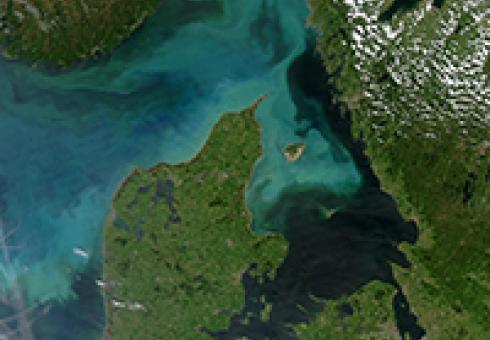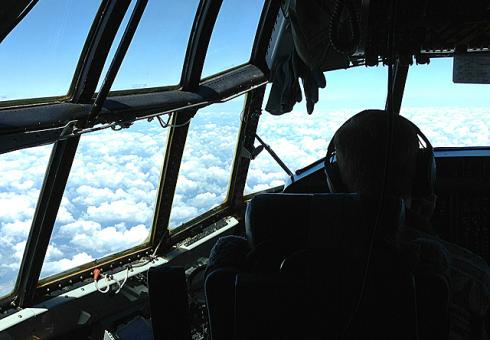News + Media
By Mark Fischetti
As Earth’s atmosphere warms, so does the ocean. Scientists have demonstrated how rising ocean temperatures and carbon dioxide levels can stress marine organisms. But a new model developed by the Massachusetts Institute of Technology reveals a surprising conclusion: If global temperature trends continue, by the end of this century half the population of phytoplankton that existed in any given ocean at the beginning of the century will have disappeared and been replaced by entirely new plankton species. “That’s going to have impacts up the food chain,” says Stephanie Dutkiewicz, principle research scientist at M.I.T.’s Program in Atmospheres, Oceans and Climate.
Rising temperatures will force all kinds of sea creatures to adjust. Tiny phytoplankton, a major food source for fish and other sea creatures, could perish as temperatures rise in an ocean region. Most at risk are the organisms in the coldest waters, which lack the resilience to adapt to warmer homes. In theory, the phytoplankton could evolve to alter their body chemistry or they could migrate elsewhere, perhaps closer to the poles. Either way, such immense change may leave species higher up the food chain unable to feed themselves.
The new model does not specify precisely how phytoplankton will respond or which fish populations might flourish or flounder, but it is sufficiently detailed to indicate that the new ocean conditions will likely lead to widespread replacement of the phytoplankton now in place. Dutkiewicz’s model accounts for 100 different phytoplankton species whereas most other models include just three or four. “With such finer resolution,” Dutkiewicz says, “we can see how significantly ecosystem structures will change.”
The results depict a complex picture. As the temperature rises, many phytoplankton produce more offspring. But less mixing occurs between deep cold waters and warm surface waters—a phenomenon known as stratification. Most nutrients that phytoplankton rely on well up from the deep, so less mixing means less sustenance for the microorganisms. Oceans at low latitudes—already considered the deserts of the sea—will provide even fewer nutrients for microorganisms, leaving even less food for the fish that feed on them.
At higher latitudes, Dutkiewicz says, higher temperatures and less mixing could force phytoplankton to stay closer to the surface, where at least some nutrients are available. More sunlight in that top layer, however, could again change the mix of micro critters. “There is a huge range in size and type of phytoplankton, which can affect the fish that graze on them,” she says.
Dutkiewicz is now beginning to lend additional realism to the model by adding more factors, such as changing levels of nitrogen and iron. Ocean acidification is also high on her list—a chemical variable that could alter competition among phytoplankton, some of which are far more adaptable to changing pH levels than others. Any of these dials on the dashboard could significantly affect the fate of whole ecosystems.
Geoengineering Lecture Series Event with MIT Joint Program on Global Change and Harvard University Center for the Environment.
Keeley Rafter
Engineering Systems Division
Noelle Selin, assistant professor of engineering systems and atmospheric chemistry, along with Amanda Giang (Technology and Policy Program graduate) and Shaojie Song (Department of Earth, Atmospheric and Planetary Sciences PhD student), recently traveled aboard the specialized NCAR C-130 research aircraft as part of a mission to measure toxic pollution in the air.
The team participated in the Nitrogen, Oxidants, Mercury and Aerosol Distributions, Sources and Sinks (NOMADSS) project. The NOMADSS project integrates three studies: the Southern Oxidant and Aerosol Study (SOAS), the North American Airborne Mercury Experiment (NAAMEX) and TROPospheric HONO (TROPHONO). Selin’s group focuses on the mercury component.
“Mercury pollution is a problem across the U.S. and worldwide,” Selin says. “However, there are still many scientific uncertainties about how it travels from pollution sources to affect health and the environment.”
Selin and her students used modeling to inform decisions about where the plane should fly and to predict where they might find pollution. Their collaborators at the University of Washington aboard the aircraft captured and measured quantities of mercury in the air, conducting a detailed sampling in the most concentrated mercury source region in North America.
“It was really exciting to experience first-hand how measurements and models could support each other to address key uncertainties in mercury science,” Giang says.
The main objectives of this project include constraining emissions of mercury from major source regions in the United States and quantifying the distribution and chemical transformations of mercury in the troposphere.
NOMADSS is part of the larger Southeast Atmosphere Study (SAS), sponsored by the National Science Foundation (NSF) in collaboration with the National Oceanic and Atmospheric Administration, the U.S. Environmental Protection Agency and the Electric Power Research Institute. This summer, the Southeast Atmosphere Study brought together researchers from more than 30 universities and research institutions from across the U.S. to study tiny particles and gases in the air from the Mississippi River to the Atlantic Ocean, and from the Ohio River Valley to the Gulf of Mexico. The study aims to investigate the relationship between air chemistry and climate change, and to better understand the climate and health impacts of air pollution in the southeastern U.S.
July 29, 2013
Alli Gold Roberts
MIT Joint Program on the Science and Policy of Global Change
Phytoplankton — small plant-like organisms that serve as the base of the marine ecosystem — play a crucial role in maintaining the health of our oceans by consuming carbon dioxide and fueling the food web. But with a changing climate, which of these vital organisms will survive, and what impact will their demise have on fish higher up the chain?
Stephanie Dutkiewicz, a researcher with the MIT Joint Program on the Science and Policy of Global Change, and her colleagues developed a model that investigates the potential effects of climate change on phytoplankton.
“Our model is unique because we were able to include 100 different species of phytoplankton, where almost all other models include just three or four,” Dutkiewicz explains. “This diversity of species allows us to analyze the ecological effects of climate change and how species will shift, adapt, thrive or die off.”
Once Dutkiewicz and her team built their phytoplankton model, they integrated it with a 3-D model of the global ocean system that is part of the Joint Program’s Integrated Global System Model (IGSM) 2.3. This comprehensive model allows the researchers to study temperature, light and circulation in terms of both the large consequences to the ocean system as a whole and the small responses individual phytoplankton have with each other.
“This model gives a nice demonstration of the complexity of the system and how you can’t just look at one piece of it to see what’s going to happen,” Dutkiewicz says.
Dutkiewicz gives an example: If a researcher just looks at the effects from a change in temperature, they would find that phytoplankton would be more productive. But when studying the whole picture, that is not the case.
On a global scale, and in the most extreme climate scenario, Dutkiewicz finds that by the end of the century half the population of phytoplankton that existed at the beginning of the century will have disappeared and been replaced by entirely new phytoplankton species.
“There will still be phytoplankton in any part of the ocean, they’ll just be different and that is going to have impacts up the food chain,” Dutkiewicz says.
Globally ocean productivity may not change much, as different impacts of changing climate might balance each other out, Dutkiewicz’s research shows. But looking regionally paints an entirely different picture. In the tropics and higher latitudes, a decrease in the nutrients these small organisms need to survive will limit phytoplankton growth. Meanwhile, in the upper latitudes, the ocean temperatures are expected to rise, spurring phytoplankton growth.
“The take home message is, studying these complex climate interactions is not simple and trying to make it simple will give you the wrong answer,” Dutkiewicz says.
Now that Dutkiewicz has built this complex marine ecosystem model, she is planning to apply it to new research. In fact, she has already added an additional type of phytoplankton that’s a nitrogen fixer, meaning it converts nitrogen into a useable form to help feed other organisms. She plans to assess how this species has changed over time. Dutkiewicz is also assessing the impacts of iron, an important nutrient in absorbing CO2, on phytoplankton populations.
Coal has been the primary fuel behind China's economic growth over the last decade, growing 10 percent per year and providing three quarters of the nation’s primary energy supply
By Michael Davidson
Coal has been the primary fuel behind China’s economic growth over the last decade, growing 10 percent per year and providing three quarters of the nation’s primary energy supply. Like China’s economy, coal’s use, sale and broader impacts are also dynamic, changing with technology and spurring policy interventions. Currently, China’s coal sector from mine to boiler is undergoing a massive consolidation designed to increase efficiency. Coal’s supreme position in the energy mix appears to be unassailable.
However, scratch deeper and challenges begin to surface. Increasingly visible health and environmental damages are pushing localities to cap coal use. Large power plants with greater minimum outputs are shackling an evolving power grid trying to accommodate new energy sources. Further centralization of ownership is rekindling decade-old political discussions about power sector deregulation and reform
This unique set of concerns begs the question: how long will coal remain king in China’s energy mix?
Read the rest at The Energy Collective...
This analysis is part of a new blog by MIT student Michael Davidson hosted by The Energy Collective on “Transforming China’s Grid.” Follow the blog here: http://theenergycollective.com/east-winds
New research in China quantifies the relationship between reduced life expectancy and elevated air pollution from coal fired boilers. MIT professor Michael Greenstone tells host Steve Curwood that residents in the north of China live 5 years less on average than those in the south as a result of higher exposure to air pollution from coal combustion.
Air pollution has taken a toll on the health of Chinese residents. A person living in the north of the River Huai can expect to lives 5 years less than a person south of the river, an unintended legacy of the government’s policy to give free coal for winter heating in the north of the country. (US Embassy)
New research in China quantifies the relationship between reduced life expectancy and elevated air pollution from coal fired boilers. MIT professor Michael Greenstone tells host Steve Curwood that residents in the north of China live 5 years less on average than those in the south as a result of higher exposure to air pollution from coal combustion.
Transcript:
CURWOOD: Highly polluted air is bad for your health, and that's particularly true when it's air full of small particles from coal-fired power plants, as studies going back for years have shown. But just how bad? Now for the first time, there's a study that actually quantifies how many years of life expectancy are lost to a given amount of particulate exposure. Michael Greenstone is a Professor of Environmental Economics at MIT. He recently published a paper that compared two populations in China that experienced very different levels of polluted air.
GREENSTONE: The basis of the study comes from a Chinese policy that was implemented during the Planning Period.
CURWOOD: This was back in the 1980s we’re talking about.
GREENSTONE: It dates really from the 1950s to the 1980 period, although the legacy of the policy remains to date. But they didn’t have enough money to provide winter heating for everybody, so they somewhat arbitrarily decided that people who live north of the Huai River, which bisects the country into north and south, would have free winter heating, and that was provided through free coal and building the infrastructure to combust the coal to create heat. And the basis of the study is to compare people who live just north of the river with people who live just to the south of the river. And I should add, in the south, it was forbidden to build heating units.

So what the study did then is it got data from 1981 to 2000 on pollution, and what we find is pretty dramatic. Living north of the river led to almost 200 micrograms per cubic meter increase in total systemic particulates. Now, of course, most people aren’t familiar with those units, so to put it in context, it was about 350 micrograms per cubic meter in the south, and 550 micrograms per cubic meter in the north, and by comparison, the US average right now is probably 40 or 50. So both the levels are enormous, and the difference between the north and south is also enormous.
CURWOOD: So what did you find when you compared life expectancy for residents in the north versus the south?
GREENSTONE: It’s remarkable. So, as I mentioned, just at the river’s edge there’s a jump up in particulates concentrations, and that’s matched by a jump down in life expectancy. Specifically, what we found is people who live north of the Huai River, and were the intended beneficiaries of these policies, have life expectancy about five-and-a-half years less than people who live to the south.
CURWOOD: How many people live in that area to the north?
GREENSTONE: In north China there’s about 500 million people, and so, from that, we deduced that the policy is causing a loss of approximately 2.5 billion life years.
CURWOOD: What kind of illnesses? What kind of deaths were these people going through?
GREENSTONE: All of the effects appear to be coming from elevated mortality rates due to cardiorespiratory causes of disease that are plausibly related to air pollution. So, lung cancer, heart attacks, other respiratory diseases. In contrast, we find no affect on mortality rates associated with causes of death that are non-cardiorespiratory.
CURWOOD: Where you able to break out just how much particulate would lead to just how much lower life expectancy?
GREENSTONE: Yes. So, in particular what we find is that an extra hundred micrograms per cubic meter of total suspended particulates is associated with a loss of life expectancy of about three years. And why that’s important is that that can be applied to other settings, both in other countries, and in other parts of China as well.
CURWOOD: Now the wind can carry air pollution from China across the Pacific Ocean to North America. Should people, say, in California be concerned about air pollution from China?
GREENSTONE: There’s always a concern about that, and it would definitely be the smaller particles that would be able to travel that far. I think probably the larger concern for Americans and really everyone who lives on the planet are the increasing rates of carbon dioxide emissions coming from China, which is a completely different pollutant, but is also associated with the combustion of coal and is causing climate change.
CURWOOD: So you don’t worry so much about particulates, you worry about CO2.
GREENSTONE: Yes. I mean, it’s worth emphasizing that China consumes more than half of the world’s coal.
CURWOOD: So what policies does China have now regarding this use of free heat in the north? And what are they doing to address the obvious public health problem?
GREENSTONE: Yes, so the legacy of the policy continues. It’s not quite in the same form. I don’t think the government is running around installing boilers anymore, but they continue to subsidize coal in the north. As an example, I’ve lectured at a university in Chengdu which is a city that’s in the south but it’s in the northern part of the south so they have cold winters. And it was just normal occurrence that when I was lecturing there was no heat in the building and all the students were wearing winter coats. So the legacy of this policy continues today. With respect to policy looking forward, I think what this study has helped to highlight is that consequences of air pollution in terms of human health are greater than what had been previously realized. And perhaps it will tilt the balance as they try to devise the optimal tradeoff between air pollution and increasing incomes.
CURWOOD: What has been the response to your study in China, privately as well as publicly?
GREENSTONE: Two of my co-authors are Chinese. One of them reported that on his microblog he had 300,000 hits in the first eight hours, and that was in response to a post describing the results. I think in the coming days and months, it will be very interesting to see what the impacts are, and the degree to which it affects Chinese policy. Candidly, China has an opportunity here to greatly improve the health of its citizens.
CURWOOD: Michael Greenstone is Professor of Environmental Economics at the Massachusetts Institute of Technology. Thanks so much, Professor Greenstone.
GREENSTONE: Thank you for having me.
Ahead of the World Energy Conference (WEC) in Daegu, South Korea, Siemens is hosting a series of panels throughout the world as part of a "Road to Daegu" series. The results of this exciting journey through the energy systems of the world will be presented at the WEC on October 13-17.
Joint Program Co-Director John Reilly participated in the U.S. panel on July 9th in Florida. The panel was on "Affordable and sustainable energy for the USA: Competitive advantage for the future?"
He was joined by Tom Kuhn, President of the Edison Electric Institute;
About the Panel
Affordability, security and sustainability are the three goals most countries are pursuing when it comes to their energy supply. In the U.S., there is a strong focus on affordability, and energy prices have always been low compared to international levels. And this is even more so today than ever before: The country’s “shale revolution” is slashing natural gas prices to all-time lows.
But can the U.S. achieve both goals – affordability and sustainability? This was the opening question at our third Round Table discussion with Michael Süß, this time held at the headquarters of Florida Power & Light in Juno Beach, Florida...
For John Reilly, Senior Lecturer at the renowned Sloan School of Management of the Massachusetts Institute of Technology, the efforts being undertaken in the U.S. on behalf of the environment aren’t enough. “We are a wealthy society in the U.S. and don’t have a real affordability problem in regard to energy prices – but what we can’t afford is not to be sustainable.”...
Read more...
Watch the panel's recap...
Watch the panel in full...
With global warming, a study finds, tropical cyclones may become more frequent and intense.
Existing research suggests that hurricanes could become stronger but less frequent thanks to climate change. But a new study says both could happen.
(Also covered by USA Today)
By: Bryan Walsh
Maybe Mayor Michael Bloomberg would have gone through the troubling of putting together a 430-page report outlining a $19.5 billion plan to save New York from the threat of climate change had Hurricane Sandy not hit last year and inflicted some $20 billion in New York City alone. But somehow I doubt it. There’s a reason that a satellite image of Hurricane Katrina highlighted the poster for An Inconvenient Truth, or that belief in man-made global warming tends to spike after extreme weather. Heat waves are uncomfortable and drought is frightening, but it’s superstorms—combined with the more gradual effects of sea-level rise—that can make climate change seem apocalyptic. Just read Jeff Goodell’s recent piece in Rolling Stone about what a major hurricane might be able to do to Miami after a few decades of warming.
But there was one hopeful side effect to climate change, at least when it came to tropical storms. The prevailing scientific opinion—seen in this 2012 report from the Intergovernmental Panel on Climate Change—is that while tropical storms are likely to become more powerful and rainier as the climate warms, they would also become less common. Bigger bullets, slower gun.
A new study in the Proceedings of the National Academy of Sciences, however, suggest that we may not be so lucky. Kerry Emanuel, an atmospheric scientist at the Massachusetts institute of Technology (MIT) and one of the foremost experts on hurricanes and climate change, argues that tropical cyclones are likely to become both stronger and more frequent as the climate continues to warm—especially in the western North Pacific, home to some of the most heavily populated cities on the planet. But the North Atlantic—meaning the U.S. East Coast and Gulf Coast—won’t be spared either. Bigger bullets, faster gun
Emanuel is going up against the conventional wisdom and much of the published literature with this paper. But the reality is that we don’t have a very good grasp of how tropical cyclone formation or strength might change in the future. As Adam Freedman points out at Climate Central, hurricanes may be huge, but they’re still too small to be easily tracked by computer climate models, which do better on a larger scale. Emanuel embedded higher-resolution regional and local models into an overarching global framework. Emanuel’s “downscaled” model simulates the development of tropical cyclones at a resolution that will increase as the storm gets stronger. For each of the six IPCC global climate models, Emanuel simulated 600 storms every year between 1950 and 2005, then ran the model forward to 2100, using an IPCC forecast that has global carbon dioxide emissions tripling by the end of the century.
Emanuel’s simulations found that the frequency of tropical cyclones will increase by 10 to 40% by 2100. And the intensity of those storms will increase by 45% by the end of the century, with storms that actually make landfall—the ones that tend to smash—will increase by 55%. As Emanuel told LiveScience:
We see an increase, in particular, toward the middle of the century. The results surprised us, but we haven’t gotten so far as to understand why this is happening.
OK, big caveats here. Emanuel is a very well-respected climatologist, but it always takes more than a single study to overturn existing scientific opinion—especially if that opinion is itself a little wobbly. Georgia Tech climatologist Judith Curry, who falls on the more skeptical side of the scientific debate on climate change, told this to Doyle Rice of USA Today:
The conclusions from this study rely on a large number of assumptions, many of which only have limited support from theory and observations and hence are associated with substantial uncertainties. Personally, I take studies that project future tropical cyclone activity from climate models with a grain of salt.
We’ll see in the decades to come whether Emanuel is right. But in a way, it may not matter all that much. As Sandy showed, hurricanes already pose a tremendous threat to our coastal cities. And that threat will continue to grow no matter what climate change does to tropical storm frequency or intensity because we’re putting more and more people and property along the water’s edge. Remember Miami? In 1926 the city was devastated by a Category 4 hurricane. (Sandy barely ranked as a Category 1 by the time it made landfall.) The difference is that there wasn’t much of a Miami back in 1926—the city’s population had just passed 100,000. Today more than 2.5 million people call Miami-Dade county home, and a hurricane of the same sort that hit in 1926 that hit now would cause $180 billion in damages. Whatever climate change does to hurricanes, we need to be ready.
This is the first post of a multi-part series on Transforming China’s Grid, where Michael Davidson will be critically examining China’s efforts to reinvent and decarbonize its power sector and related energy goals. He begins with China’s efforts to create provincial and city-level carbon trading pilots as well as major obstacles to establishing a national system that can link with other ETS markets.
By Michael Davidson
China’s first mandatory carbon emissions trading system (ETS) pilot debuted last month before a packed auditorium in the southern city of Shenzhen. China’s first official carbon trade was greeted with fanfare and a well-choreographed script of climate officials. Shenzhen is the first of seven cities and provinces expected to unveil cap-and-trade programs in China this year, which drew skeptical reactions from foreign onlookers based on the first day’s low volume – 21,120 tons at 28-30 yuan / ton ($4.55-$5.05).
The ETS pilots are a small market-based component of a broader climate policy that has historically relied on administrative measures carried in five-year plans. The overriding priorities for provincial officials are energy and carbon intensity reduction targets, most recently allocated in 2011. Nationally, these amount to 16% and 17% reductions in energy use and carbon emissions per unit GDP, respectively, by 2015; a 40-45% carbon intensity reduction below 2005 levels by 2020. However, ensuring an early emissions peak (i.e., before 2030) will require more flexible approaches, in particular, market mechanisms, for which the ETS pilots are a useful bellwether. While the merits of the pilots should not be judged by the first trading day, significant obstacles stand in the way of creating a national ETS by 2016, as currently envisioned by the Chinese leadership. Even before the remaining six trading pilots ring the opening bell, we have a good sense of what these obstacles will be.
Read the rest on The Energy Collective...
Ahead of the World Energy Conference (WEC) in Daegu, South Korea, Siemens is hosting a series of panels throughout the world as part of a "Road to Daegu" series. The results of this exciting journey through the energy systems of the world will be presented at the WEC on October 13-17.
Joint Program Co-Director John Reilly participated in the U.S. panel on July 9th in Florida. The panel was on "Affordable and sustainable energy for the USA: Competitive advantage for the future?"







